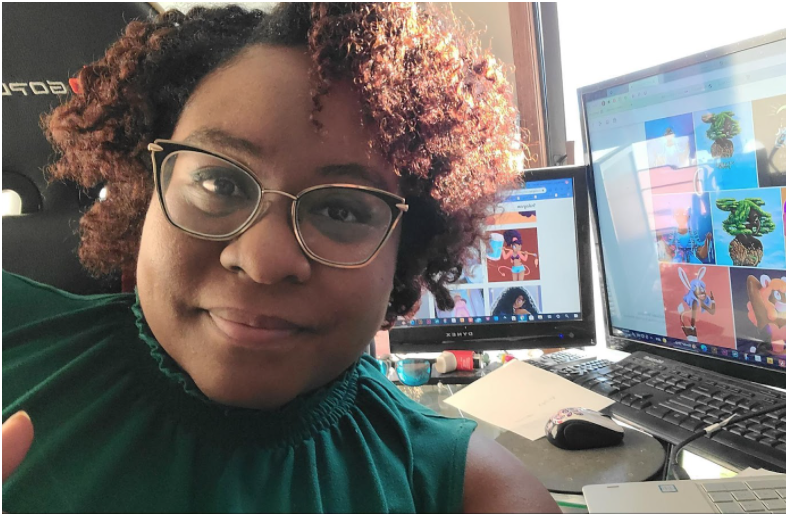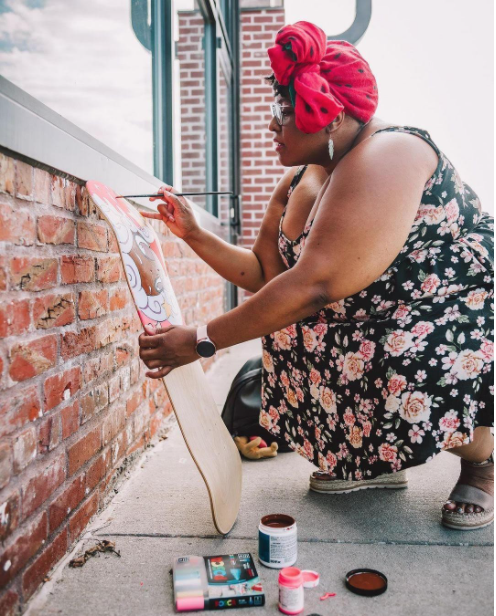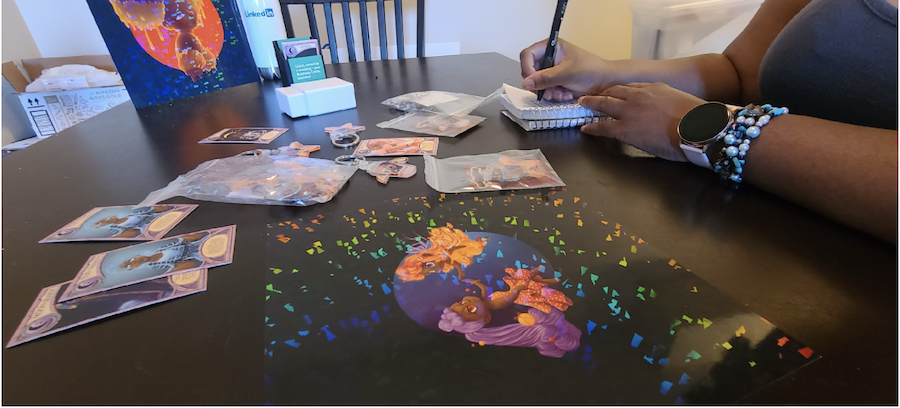Career stories: Blending analytics and design thinking
January 4, 2022
An experienced quality assurance analyst and credentialed graphic designer, Michaela was seeking in her next role added flexibility, and the opportunity to blend both her analytical and creative skills. She found it in LinkedIn Engineering’s Trust & Safety team in her hometown of Omaha, Nebraska.
My professional background is really a two-fold story. In my Quality Assurance (QA) roles, I’ve primarily held positions that required me to think in a more linear fashion, such as detecting banking fraud and processing credit card chargebacks. In these roles, decision-making is typically by the book, following established operating procedures. Although there’s no way to write a perfect policy that encompasses every possible situation facing clients, an overly process-oriented approach can feel limiting sometimes.
Infusing my creative side
The other half of my resume is all creative work: I run a small business as an illustrator and graphic designer during my evenings and weekends. While some might be overwhelmed by these competing demands, I find that the roles give energy to each other. When I’m running out of steam on a QA work project, a graphic design assignment will lift me up and vice versa.
In past roles, it was rare that I could incorporate the two sides of my personality into one project. However, my LinkedIn team has been incredibly supportive of my work as both a quality assurance analyst and artist.
The company offers a lot of flexibility too—from paid shutdown weeks annually to discretionary time off to monthly No Meeting Fridays, among other flexibility benefits—which gives me the space to also follow my personal passions as a designer. I’ve even had the opportunity to formally blend the two worlds, designing an icon for LinkedIn’s internal Workbench tool, which allows us to monitor jobs posted on the platform.
Meaningful work, protecting our members
I was actively looking for a role that would allow me more autonomy and space for critical thinking when a LinkedIn recruiter first approached me. I interviewed for two jobs, and was offered the position of senior analyst on our Trust & Safety team (i.e., LinkedIn’s QA team), working hybrid from my home and our LinkedIn Omaha office.
In my role, I specialize in our Jobs Fraud work: identifying and curbing spam and fraudulent job postings from appearing on LinkedIn—often interpreting and presenting data for various parts of LinkedIn. This important work protects our members (i.e., LinkedIn users), job seekers, and businesses from bad actors; and is a major reason why members trust us more than any other social platform.
Working in QA is a great way to work in tech and directly contribute to solving social problems. Jobs fraud is a prime example of this. With the rise of work-from-home jobs, we’ve ensured that job postings are in line with our policies and aren’t fraudulent (e.g., jobs that don’t offer the stability or compensation of a robust position). I’ve also been an active part of making changes to search filters and other product features to continue curbing bad actors on our platform, and to protect job seekers and employers alike. It’s incredibly rewarding to help businesses usher in new talent, and job seekers find their dream jobs.
Mentorship and learning
Even before I started, LinkedIn felt like the perfect home for someone like me: ambitious and multi-faceted. For example, while I started my LinkedIn onboarding and initial training, my manager, Amy, encouraged me to also explore supplementary trainings outside of my core Jobs Fraud specialty team.
For instance, I jumped into additional learning with Abuse & Content Enforcement, a sister Trust & Safety specialty team focused on protecting members from spam and non-professional content on LinkedIn.com. It turned out to be an invaluable preview into an entirely different arm of our business, as well as potential growth opportunities for me in time.
Since the moment I met her, my manager Amy has continued to be a trusted mentor for me. As a skilled subject matter expert with over 10 years of QA experience at LinkedIn alone, she’s helped me not only to develop professionally in QA and think thoughtfully about growth opportunities, but also recognize when I need to take time for self-care. I’m incredibly hardworking and take a lot of pride in my work, and she’s taught me a ton about striking that balance of working hard and giving yourself that critical time to relax, reset, and follow your personal passions, too.
Support and autonomy
For the first time in my career, I found a position that would leverage both my analytical abilities and my imaginative side. Creative thinking is valued here at LinkedIn, and I’m given the license and resources to put my ideas into practice. It's not a plug-and-chug role, like many QA positions at other companies.
Instead, I have the ideal balance of both structured QA guidelines, and the autonomy to fully leverage my QA expertise to evaluate the intent of a job posting, and make an informed decision on the course of action. It’s challenging, but it’s fun, too, and it’s incredibly rewarding to be trusted as a leader and subject-matter expert.
Cross-functional collaboration
This position also offers the opportunity to work across teams in a way that simply wasn’t possible in other organizations. At LinkedIn, we freely move information across different department lines and actively break down any siloes—teaming with LinkedIn product managers, engineers, data scientists, and operations analysts, among others.
For instance, as a more senior member of our team, I serve as a coach to many of our Trust & Safety analysts, and work closely with colleagues in our Trust & Safety training team. As a fast-growing department, it’s especially important for us to be in lockstep with our training team to identify trends and gaps—so we coaches and our trainers can collaboratively help our Trust & Safety analysts grow, develop, and succeed.
Having such a great rapport with other teams allows us to solve problems in a collaborative way. So in situations where we find that all the analysts are making similar mistakes, we can proactively identify them, and adjust our training programs to set dozens of new and experienced analysts up for success.
This spirit of partnership extends to other parts of my job as well. While I found it easy to acclimate as an analyst, for others, it takes time to understand the ins and outs of the position, while balancing being a parent, among other priorities. What I enjoy most is making others better at what they do, and helping them improve their numbers and adjust to new concepts. I’ve often been the one asking questions as a more junior analyst, so it’s great to work at a place that allows me to pay it forward as a senior analyst, and collaboratively share everything I’ve learned with my teammates.
Advice for recruits
When people ask me how to evaluate a potential job opportunity, I tell them to do their research and ask questions: “What do you like about the company? What would you change?” Mine your network for friends, past colleagues, and other second-degree connections—and set up time for a (virtual) coffee chat to learn about their career experiences at the company.
For me, I knew autonomy, flexibility, and creative/analytical thinking were important attributes for me in a new role; and my conversations with my now-manager Amy and others were an invaluable part of the job-search and recruiting process.
Work is a huge part of your life—so make sure you completely understand how the job fits into the company as a whole and even the wider world. It’s important to do extra due diligence when job searching, so you’re well-positioned to find that ideal job match.
About Michaela
Based in Omaha, Nebraska, Michaela is a senior analyst on LinkedIn Engineering’s Trust & Safety team—focused on identifying and curbing jobs fraud. Prior to LinkedIn, she served as a quality assurance analyst and medical underwriter at various companies, including First Data Corporation, Mutual of Omaha, North End Teleservices, and PayPal. Michaela also owns and operates an illustration and graphic design company, Painted Wolf Studio, and holds a bachelor’s in graphic design from the University of Nebraska-Lincoln.
Editor’s note: Considering an engineering/tech career at LinkedIn? In this Career Stories series, you’ll hear first-hand from our engineers and technologists about real life at LinkedIn—including our meaningful work, collaborative culture, and transformational growth. For more on tech careers at LinkedIn, visit: lnkd.in/EngCareers.



